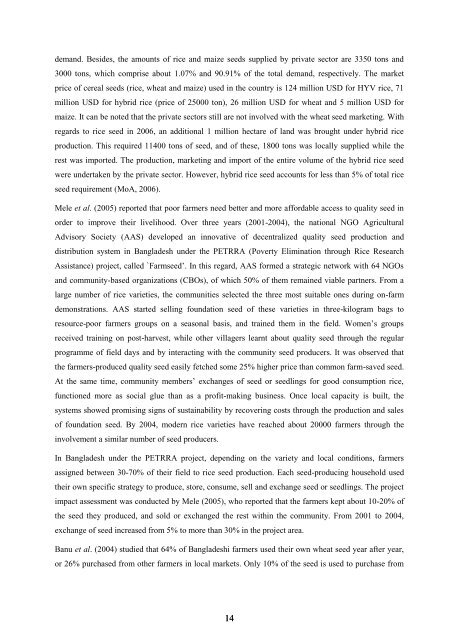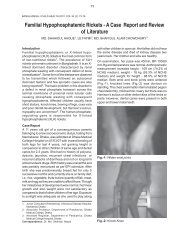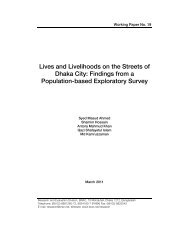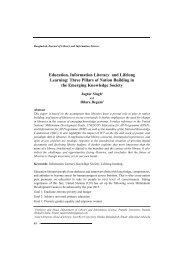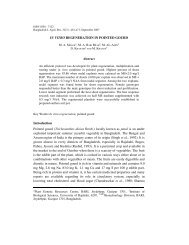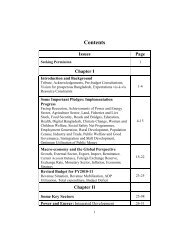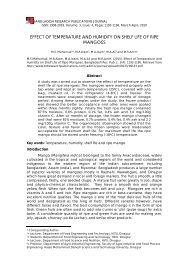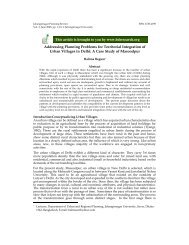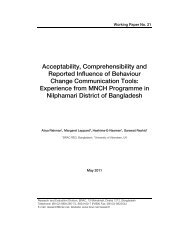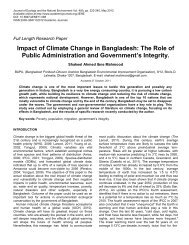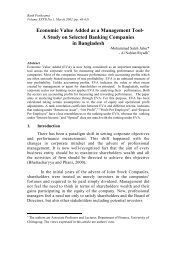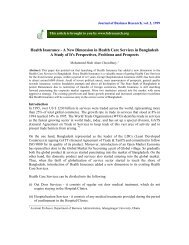Studies on Policy Option for Quality Seed Production and ... - NFPCSP
Studies on Policy Option for Quality Seed Production and ... - NFPCSP
Studies on Policy Option for Quality Seed Production and ... - NFPCSP
You also want an ePaper? Increase the reach of your titles
YUMPU automatically turns print PDFs into web optimized ePapers that Google loves.
dem<strong>and</strong>. Besides, the amounts of rice <strong>and</strong> maize seeds supplied by private sector are 3350 t<strong>on</strong>s <strong>and</strong>3000 t<strong>on</strong>s, which comprise about 1.07% <strong>and</strong> 90.91% of the total dem<strong>and</strong>, respectively. The marketprice of cereal seeds (rice, wheat <strong>and</strong> maize) used in the country is 124 milli<strong>on</strong> USD <strong>for</strong> HYV rice, 71milli<strong>on</strong> USD <strong>for</strong> hybrid rice (price of 25000 t<strong>on</strong>), 26 milli<strong>on</strong> USD <strong>for</strong> wheat <strong>and</strong> 5 milli<strong>on</strong> USD <strong>for</strong>maize. It can be noted that the private sectors still are not involved with the wheat seed marketing. Withregards to rice seed in 2006, an additi<strong>on</strong>al 1 milli<strong>on</strong> hectare of l<strong>and</strong> was brought under hybrid riceproducti<strong>on</strong>. This required 11400 t<strong>on</strong>s of seed, <strong>and</strong> of these, 1800 t<strong>on</strong>s was locally supplied while therest was imported. The producti<strong>on</strong>, marketing <strong>and</strong> import of the entire volume of the hybrid rice seedwere undertaken by the private sector. However, hybrid rice seed accounts <strong>for</strong> less than 5% of total riceseed requirement (MoA, 2006).Mele et al. (2005) reported that poor farmers need better <strong>and</strong> more af<strong>for</strong>dable access to quality seed inorder to improve their livelihood. Over three years (2001 -2004), the nati<strong>on</strong>al NGO AgriculturalAdvisory Society (AAS) developed an innovative of decentralized quality seed producti<strong>on</strong> <strong>and</strong>distributi<strong>on</strong> system in Bangladesh under the PETRRA (Poverty Eliminati<strong>on</strong> through Rice ResearchAssistance) project, called `Farmseed’. In this regard, AAS <strong>for</strong>med a strategic network with 64 NGOs<strong>and</strong> community-based organizati<strong>on</strong>s (CBOs), of which 50% of them remained viable partners. From alarge number of rice varieties, the communities selected the three most suitable <strong>on</strong>es during <strong>on</strong>-farmdem<strong>on</strong>strati<strong>on</strong>s. AAS started selling foundati<strong>on</strong> seed of these varieties in three-kilogram bags toresource-poor farmers groups <strong>on</strong> a seas<strong>on</strong>al basis, <strong>and</strong> trained them in the field. Women’s groupsreceived training <strong>on</strong> post-harvest, while other villagers learnt about quality seed through the regularprogramme of field days <strong>and</strong> by interacting with the community seed producers. It was observed thatthe farmers-produced quality seed easily fetched some 25% higher price than comm<strong>on</strong> farm-saved seed.At the same time, community members’ exchanges of seed or seedlings <strong>for</strong> good c<strong>on</strong>sumpti<strong>on</strong> rice,functi<strong>on</strong>ed more as social glue than as a profit-making business. Once local capacity is built, thesystems showed promising signs of sustainability by recovering costs through the producti<strong>on</strong> <strong>and</strong> salesof foundati<strong>on</strong> seed. By 2004, modern rice varieties have reached about 20000 farmers through theinvolvement a similar number of seed producers.In Bangladesh under the PETRRA project, depending <strong>on</strong> the variety <strong>and</strong> local c<strong>on</strong>diti<strong>on</strong>s, farmersassigned between 30-70% of their field to rice seed producti<strong>on</strong>. Each seed-producing household usedtheir own specific strategy to produce, store, c<strong>on</strong>sume, sell <strong>and</strong> exchange seed or seedlings. The projectimpact assessment was c<strong>on</strong>ducted by Mele (2005), who reported that the farmers kept about 10-20% ofthe seed they produced, <strong>and</strong> sold or exchanged the rest within the community. From 2001 to 2004,exchange of seed increased from 5% to more than 30% in the project area.Banu et al. (2004) studied that 64% of Bangladeshi farmers used their own wheat seed year after year,or 26% purchased from other farmers in local markets. Only 10% of the seed is used to purchase from14


